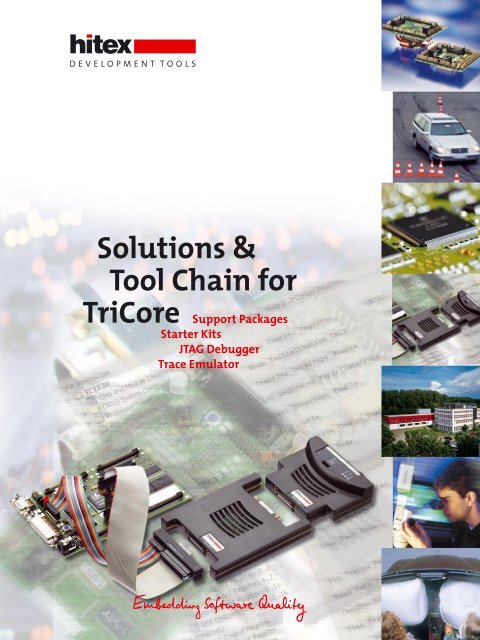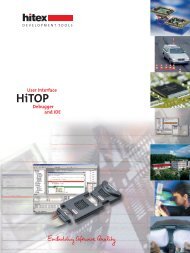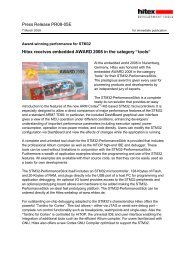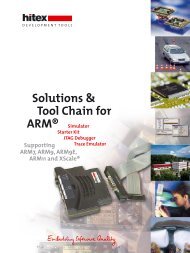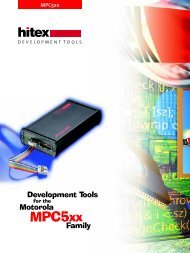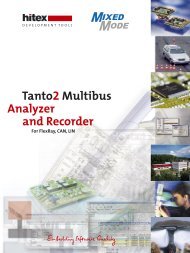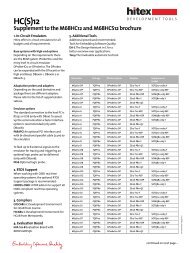TriCore - Hitex UK
TriCore - Hitex UK
TriCore - Hitex UK
You also want an ePaper? Increase the reach of your titles
YUMPU automatically turns print PDFs into web optimized ePapers that Google loves.
Solutions &<br />
Tool Chain for<br />
<strong>TriCore</strong> Support Packages<br />
Starter Kits<br />
JTAG Debugger<br />
Trace Emulator
<strong>TriCore</strong> TM Architecture<br />
and <strong>Hitex</strong> Solutions<br />
MCU Features<br />
-> Fast context switch & low interrupt latency<br />
-> 16-bit and 32-bit instruction formats<br />
-> Powerful bit manipulation support<br />
<strong>TriCore</strong> Benefits<br />
-> Integrated MCU-DSP instructions in one core<br />
-> Fast and efficient processing of multiple tasks<br />
in one engine<br />
-> Low code size and inherent high-level<br />
language support<br />
-> One development toolset for both MCU and DSP tasks<br />
-> Higher flexibility and lower costs<br />
Processor Features<br />
-> 32-bit load-store Harvard architecture<br />
-> Superscalar execution<br />
-> 16 address and 16 data registers<br />
Architecture Overview<br />
<strong>TriCore</strong> is the first single-core 32-bit MCU-DSP<br />
architecture optimized for real-time embedded systems<br />
which truly unifies the best of three worlds: realtime<br />
capabilities of microcontrollers, computational<br />
prowess of DSPs, and the highest performance/price<br />
implementations of RISC load-store architectures.<br />
The <strong>TriCore</strong> architecture is implemented as a family of<br />
cores that offer tremendous scalability in terms of both<br />
price and performance. In fact, the native MCU-DSP<br />
capabilities of the architecture allow system designers to<br />
fine-tune the MCU and DSP performance in the software<br />
of each <strong>TriCore</strong> core.
Support Packages<br />
& Starter Kits<br />
Easy Evaluation with a Complete Starter Kit<br />
If you are looking for easy evaluation and development<br />
using a 32-bit microcontroller, which offers maximum<br />
flexibility and high performance for your automotive or<br />
industrial applications, we have developed the perfect<br />
solution – the <strong>TriCore</strong> Starter Kits.<br />
The <strong>TriCore</strong> Starter Kits provide all hardware and<br />
software necessary for evaluating Infineon‘s highperforming<br />
32-bit single-chip microcontroller, and can be<br />
used for the development and testing of microcontroller<br />
systems. It is perfectly suited to the development and<br />
testing of your microcontroller systems.<br />
<strong>TriCore</strong><br />
Board Support Package<br />
The <strong>TriCore</strong> Board Support Package consists of:<br />
Hardware<br />
The TriBoard evaluation boards include all components<br />
needed to familiarize yourself with <strong>TriCore</strong> features<br />
-> 4MB external memory<br />
-> Interfaces that connect to external hardware such as<br />
extension boards or debugger<br />
-> Wiggler interface for direct connection to PC via<br />
parallel cable (included) for software download, flash<br />
programming and debug<br />
All starter kits can be obtained directly from <strong>Hitex</strong>.<br />
-> DAvE Digital Application Virtual Engineer –<br />
Automatic Startup Code Generation<br />
-> GNU C / C++ Compiler for <strong>TriCore</strong> Demo Version<br />
-> DAC – Development Assistant for C – evaluation<br />
version<br />
-> Tessy – The Invaluable Test Tool – evalution version<br />
-> eLinux – real-time operating system<br />
-> HiTOP5 – ultimate and class-leading user interface<br />
from <strong>Hitex</strong> – code size limited version (64k)<br />
The latest release supports all existing and just recently<br />
released <strong>TriCore</strong> derivatives. Besides the automotive<br />
derivatives TC17xx, the new TC11xx and the TC19xx are<br />
also fully supported. The debugger communicates<br />
via the parallel port to the the starter kit’s on-board<br />
„wiggler“. No additional debug hardware is necessary.
JTAG Debugging<br />
& Trace Emulation<br />
The Upgradable Solution<br />
for Real-time Debugging<br />
The basic Tanto <strong>TriCore</strong> system consists of the universal<br />
Tanto Base module and a <strong>TriCore</strong>-specific Port Link<br />
module (TantoPL-<strong>TriCore</strong>) that allows the direct<br />
connection of the test and analysis tool to the OCDS port<br />
in the target system. Together with our HiTOP high-level<br />
language debugger, Tanto provides software breakpoints<br />
in addition to the integral hardware breakpoints and<br />
complex triggers supported by the OCDS.<br />
It also implements ”on-the-fly” access to any internal<br />
or external memory location plus internal special<br />
function register in real-time. PCP debugging is fully<br />
implemented, offering special triggers, disassembly of<br />
the PCP code, and high-level language support. The PCP<br />
can be controlled independently from the <strong>TriCore</strong> CPU,<br />
allowing PCP execution to be halted while the <strong>TriCore</strong><br />
program is still running. The synchronous break of the<br />
PCP and <strong>TriCore</strong> is also available.<br />
TantoPT <strong>TriCore</strong> –<br />
The Extension for Program Flow Analysis<br />
The TantoPT module offers enhanced functions for<br />
debugging complex systems in real-time. It supports the<br />
second OCDS level, and adds a powerful hardware trace<br />
module to record 1 M trace frames with timestamps.<br />
A special hardware filter eliminates redundant<br />
information coming from the OCDS trace port ensuring<br />
optimal usage of Tanto’s trace memory.<br />
Compared to an unfiltered trace, this allows up to 5<br />
times more data to be recorded. Traced information is<br />
freely accessible during emulation without disturbing<br />
program execution. As each trace frame contains a<br />
timestamp (10 ns resolution), a statistical performance<br />
analysis can be carried out. The full trace functionality<br />
is also available for the PCP, allowing qualified trace<br />
recording, and various trigger possibilities.<br />
The trace data can be displayed in numerous formats,<br />
including execution traces and signal traces, to allow<br />
the best possible analysis. The linking of the trace to the<br />
source window and to a powerful (hardware integrated)<br />
search engine facilitate rapid navigation in the recorded<br />
data, and provide a complete overview of the program<br />
flow. Tanto’s fast analysis algorithms allow an immediate<br />
display of the recorded data on the user’s screen, even<br />
while the CPU is still running. Thus, the trace data can be<br />
searched and analyzed without real-time violation.
HiTOP User Interface<br />
& Unit Tests with Tessy<br />
HiTOP Debugger<br />
Our universal user interface HiTOP supports very<br />
sophisticated HLL-Debugging, and allows an easy<br />
transition between different types of tools and CPU<br />
platforms. The HiTOP debugger offers software and<br />
hardware breakpoints and implements fast-breaks for<br />
on-the-fly access to any memory and internal register.<br />
The on-chip Flash memory is fully supported by HiTOP<br />
and can directly be programmed using user-friendly<br />
commands.<br />
HiTOP supports the following compilers:<br />
-> Tasking C/C++/EC++<br />
-> Green Hills C/C++/EC++<br />
-> HighTec GNU C/C++ (on request)<br />
The Operating Environments<br />
HiTOP supports all leading compilers and their object<br />
formats. Many third-party tools are well integrated with<br />
HiTOP because of the acceptance of HiTOP as standard<br />
emulation control software. HiTOP also supports all<br />
major embedded real-time operating systems, giving<br />
a fully transparent overview of your whole software<br />
system at any time by displaying information such as<br />
task lists, the status of a specific task, message queues,<br />
delays, and memory objects.<br />
Tessy: Automated Unit Test<br />
Tessy performs automatic and dynamic unit testing<br />
of embedded software and facilitates all other aspects<br />
of software testing. It helps increase productivity and<br />
save time during an embedded development project,<br />
particularly when it comes to regression testing.<br />
Regression testing itself is a key feature in achieving<br />
software quality:<br />
> Automated unit testing of embedded software<br />
> Easy to begin use<br />
> Saves test data for re-use<br />
> Ideal for regression testing<br />
> Unlimited number of test cases<br />
> C1 code coverage<br />
> Test documentation in HTML format<br />
> ASAP2 support<br />
> Integrates with HiTOP<br />
> Includes CTE – Classification Tree Editor<br />
HiTOP supports the following RTOS<br />
-> CMX-RTX (CMX)<br />
-> Nucleus Plus (Accelerated Technology)<br />
-> PXROS (HighTec)<br />
-> OSEK (ProOSEK, osCAN, ERCOSEK, VxWorks)
Technical Data<br />
HiTOP Board Support Package for <strong>TriCore</strong> Starter Kit<br />
Host Connections<br />
Operating Software<br />
Run Control Functions<br />
LPT<br />
HiTOP5<br />
Run, Halt, Single Step, Line Step, 20 Software Breakpoints, 4 Hardware Breakpoints<br />
Target Adaptation Internally connected to OCDS Level 1<br />
Tanto Base<br />
Host Connections<br />
Operating Software<br />
Run Control Functions<br />
External Signals<br />
Operating Voltage<br />
USB (V1.1), Serial (115 kBaud), Ethernet (10BaseT)<br />
HiTOP5<br />
Run, Halt, Single Step, Line Step, 20 Software Breakpoints, 4 Hardware Breakpoints<br />
Trigger out, Trigger in<br />
Supports Debug Port voltages between 1.8 and 5.0 Volts<br />
Dimensions 100 x 36 x 80 mm (W x H x D)<br />
Target Adaptation<br />
Tanto Port Trace (PT)<br />
Trace Depth / Trace Width<br />
Trigger Functions<br />
Time Measurements<br />
Supported Frequencies<br />
External Signals<br />
Operating Voltage<br />
Dimensions<br />
Optional Expansion Module<br />
Directly to OCDS Level 1 connector, or via combined footprint adapter*<br />
1M frames / 32 channels<br />
4 triggers (each with an associated counter), 4 level sequencer,<br />
qualified trace recording (depending on the functionality of supported chip)<br />
Time stamps with 10 ns resolution<br />
Up to 133 MHz (200 MHz in preparation)<br />
8 I/O signals (configurable: 4 in plus 4 out, or alternatively 8 in)<br />
Supports Debug Port voltages between 1.8 and 5.0 Volts<br />
100 x 17 x 125 mm (W x H x D, Tanto PT module), 100 x 36 x 179 mm (with Tanto Base)<br />
Tanto Data Probe (8 I/O signals)<br />
Target Adaptation Directly to OCDS Level 1 connector, or via combined footprint adapter *<br />
Supported Derivatives<br />
* merges OCDS Level 1 and OCDS Level 2 signals to one interface<br />
Derivative Package f max Port Trace Connector<br />
Proposed<br />
Related Applications<br />
TC1130 P-LBGA208 150MHz HS, HS-C Industrial / General Purpose<br />
TC11IB P-BGA338 100MHz HS, HS-C Industrial / General Purpose<br />
TC1765 P-BGA260 40MHz LS, HS, HS-C Automotive<br />
TC1775 P-BGA329 40MHz LS, HS, HS-C Automotive<br />
TC1796 P-LBGA416 150MHz HS, HS-C Automotive<br />
TC1910 P-BGA256 100MHz HS, HS-C Infotainement<br />
TC1912 P-BGA256 100MHz HS, HS-C Infotainement<br />
TC1920 P-BGA256 100MHz HS, HS-C Infotainement<br />
IWORX (PXB/PXF 4225) P-BGA388 120MHz HS, HS-C Communication Network<br />
Harrier-XT P-BGA272 50MHz LS, HS, HS-C ATM/HDLC Access Networks<br />
If you don‘t find your derivative in this list, please<br />
contact your local <strong>Hitex</strong> representative!<br />
Type LS: Standard (low speed) connector<br />
Type HS: High speed connector<br />
Type HS-C: High speed combined connector.<br />
B2-<strong>TriCore</strong>Tools Aug-2004-001


